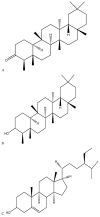Evaluating the Metabolomic Profile and Anti-Pathogenic Properties of Cannabis Species
- PMID: 38786730
- PMCID: PMC11122914
- DOI: 10.3390/metabo14050253
Evaluating the Metabolomic Profile and Anti-Pathogenic Properties of Cannabis Species
Abstract
The Cannabis species is one of the potent ancient medicinal plants acclaimed for its medicinal properties and recreational purposes. The plant parts are used and exploited all over the world for several agricultural and industrial applications. For many years Cannabis spp. has proven to present a highly diverse metabolomic profile with a pool of bioactive metabolites used for numerous pharmacological purposes ranging from anti-inflammatory to antimicrobial. Cannabis sativa has since been an extensive subject of investigation, monopolizing the research. Hence, there are fewer studies with a comprehensive understanding of the composition of bioactive metabolites grown in different environmental conditions, especially C. indica and a few other Cannabis strains. These pharmacological properties are mostly attributed to a few phytocannabinoids and some phytochemicals such as terpenoids or essential oils which have been tested for antimicrobial properties. Many other discovered compounds are yet to be tested for antimicrobial properties. These phytochemicals have a series of useful properties including anti-insecticidal, anti-acaricidal, anti-nematicidal, anti-bacterial, anti-fungal, and anti-viral properties. Research studies have reported excellent antibacterial activity against Gram-positive and Gram-negative multidrug-resistant bacteria as well as methicillin-resistant Staphylococcus aureus (MRSA). Although there has been an extensive investigation on the antimicrobial properties of Cannabis, the antimicrobial properties of Cannabis on phytopathogens and aquatic animal pathogens, mostly those affecting fish, remain under-researched. Therefore, the current review intends to investigate the existing body of research on metabolomic profile and anti-microbial properties whilst trying to expand the scope of the properties of the Cannabis plant to benefit the health of other animal species and plant crops, particularly in agriculture.
Keywords: Cannabis; antibacterial properties; antimicrobial properties; fish pathogens; metabolomic profile; phytocannabinoids; phytopathogens.
Conflict of interest statement
The authors declare no conflicts of interest.
Figures






References
Publication types
Grants and funding
LinkOut - more resources
Full Text Sources
Medical
Miscellaneous

